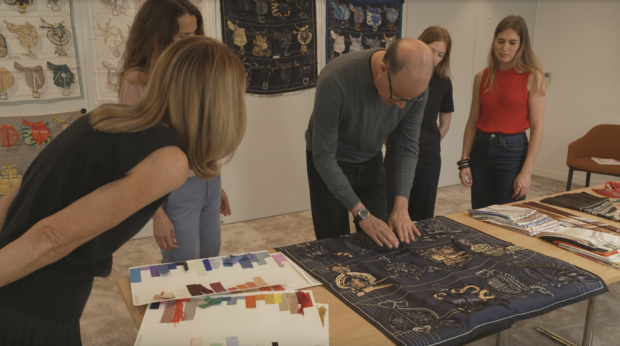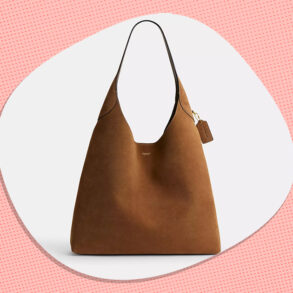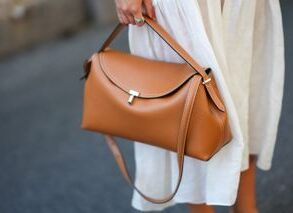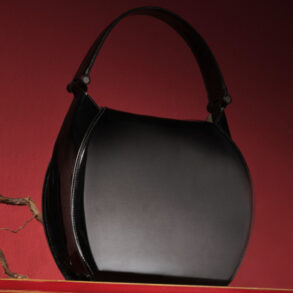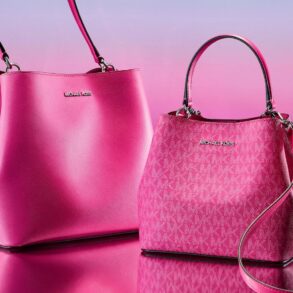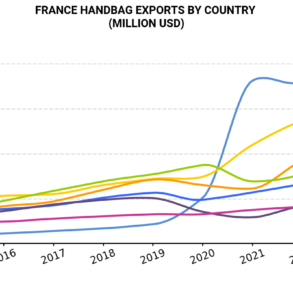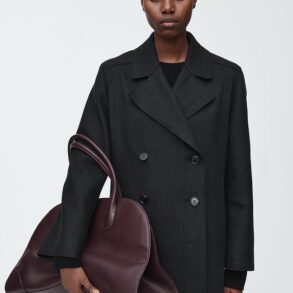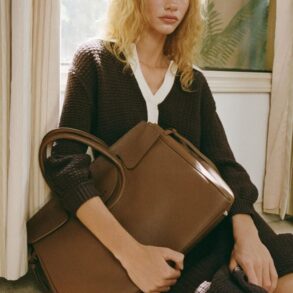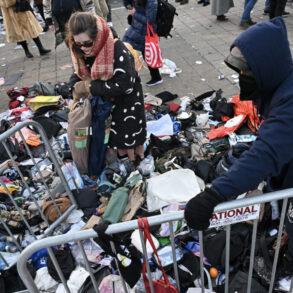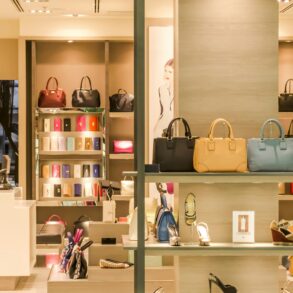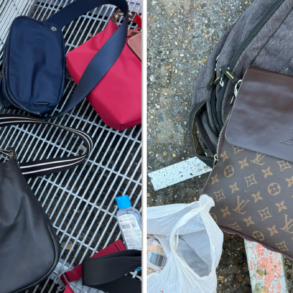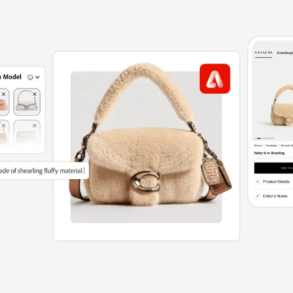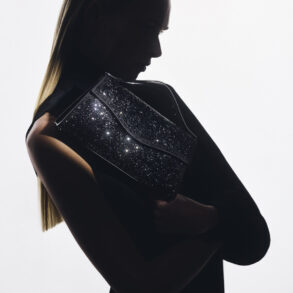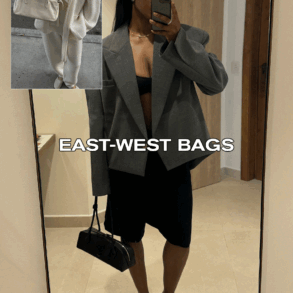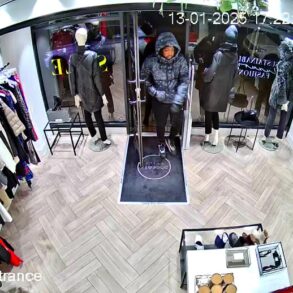In Greek mythology, Hermes, the son of Zeus was imagined with winged sandals, and a winged hat, symbols of his celebrated speed. Today, the French fashion house Hermès that shares his name is also known for its accessories…elegant scarves, ties and handbags all meticulously made but at a glacial pace. It can take years for monied customers to get their hands on certain Hermès handbags, a process steeped in more mythology than even the Greeks could’ve imagined. The craft and culture behind the brand has been preserved for nearly 200 years, by one family, and is seldom seen by outsiders. But this spring, we were invited to Paris to spend some time behind the silk curtains of the house of Hermès.
On a rainy afternoon, we watched as Pierre-Alexis Dumas, the artistic director of Hermès, turned his discerning eye to dozens of potential scarf designs. Colors and patterns displayed on what looked like the world’s chicest clothesline. Hermès scarves are screened and stitched by hand. Some designs two years in the making. The only part of the process that happens quickly is this. Dumas chose the colors for next season’s scarves in less than an hour.
Pierre-Alexis Dumas: I’m a happy man. Bravo!
Cecile Pesce: Merci! Pierre-Alexis
Pierre-Alexis Dumas: Et voila. Look at the disaster…A mountain of hope reduced to ashes.
60 Minutes
The house of Hermès wasn’t built on silk but rather, saddles. In 1837, Thierry Hermès began selling bespoke harnesses in Paris. That led to luggage, and eventually handbags. More than a century later, Hermès is a more than $200 billion luxury brand with a catalog that includes everything from ready-to-wear to jewelry and furniture. Pierre-Alexis Dumas is the sixth generation of his family to take the reins.
Pierre-Alexis Dumas: I think it’s a wonderful way to enter the store.
He took us through a tunnel of orange boxes into 24 Faubourg in Paris, Hermès flagship and heart for more than a century.
Pierre-Alexis Dumas: My grandfather worked here, and then my father worked here. When I was a child, his office, just on the first floor. Now it’s the jewelry section.
The store is like the Louvre of luxury goods, complete with reminders to look but don’t touch. The brand’s masterpieces include this $48,000 purse and, if you have money left over, this $272,000 pool table.
Sharyn Alfonsi: Do you ever make a decision based on cost? Budget? Like, “This will be less expensive if we do it this way.”
Pierre-Alexis Dumas: I can’t work like that. I’ve always heard that Hermès is very costly. It’s not expensive. It’s costly.
Sharyn Alfonsi: What’s the difference?
Pierre-Alexis Dumas: The cost is the actual price of making an object properly with the required level of attention so that you have an object of quality. Expensive is a product, which is not delivering what it’s supposed to deliver, but you’ve paid quite a large amount of money for it, and then it betrays you. That’s expensive.
60 Minutes
A distinctly French philosophy stitched into the DNA of Hermès. Dumas says the company has never had a marketing department. Its allure, he says, comes from a century of superb craftsmanship and serendipity. Take this trapezoid shaped purse. In 1935, Dumas’ grandfather designed the bag; it wasn’t a hit. But as legend has it, 20 years later, an expecting Grace Kelly used the bag to hide her belly from peering paparazzi. Soon women flooded Hermès, asking for what was eventually renamed the Kelly bag. Hermès scarves have been favored by American royalty and actual royalty for decades. The kind of product placement money can’t buy. Even the brand’s famous citrus-colored boxes, a color the company trademarked in the U.S., was a happy accident of the 1940s.
Pierre-Alexis Dumas: In 1946 there was shortage of everything. And when my great uncle went to see– his supplier of paper, manufacturing boxes. The supplier said, “I’m sorry, we don’t have that beige paper anymore.
Sharyn Alfonsi: Because of the war?
Pierre-Alexis Dumas: Yeah, because of the war and short supplies and he said– “I only have that stock of that roll of orange paper that nobody wants.”
Sharyn Alfonsi: Eyes light up when they see that orange–
Pierre-Alexis Dumas: Serendipity.
And it was serendipity that led to the piece de resistance at Hermès, “the Birkin,” designed in 1984 by Dumas’ father after he was seated next to British actress Jane Birkin on a flight to London.
Pierre-Alexis Dumas: And she told him, “Well, let me tell you, I’m not happy about my bag. I want something more loose with bigger handles, and ease– and– and always open when I carry it.” And as she was talking, my father was very good at sketching.
Sharyn Alfonsi: He sketched it right there in that moment?
Pierre-Alexis Dumas: Yeah. But just an idea. You know? “A bit something like that?” And she said, “Yeah. That would be great.”
It was. Today, the Birkin is the most coveted and costly handbag in the world. A Birkin retails around $9,000 and at auction can fetch upwards of hundreds of thousands of dollars. But here is the surreal twist of Hermès exclusivity, even if you can afford to buy a Birkin bag – chances are you can’t. The stores typically don’t have any to sell. Dumas says Hermès simply can’t keep up with demand.
60 Minutes
Sharyn Alfonsi: If somebody wants the bag, how do they get the bag?
Pierre-Alexis Dumas: Well, you have to walk into an Hermès store, and uh– you have to be patient.
Sharyn Alfonsi: But you know the world we live in, right? You know that if somebody’s– has the funds and they want the bag, they want the bag now.
Pierre-Alexis Dumas: Yes. Um, I have children too. And I have desires too. But I’m saying it’s a long process. You go to a store. You get an appointment. You meet a salesperson. You talk about what you want. It’s not available. You’ll have to wait. They’ll come back to you. It takes a long time. Eventually, it’s gonna happen.
Store managers act as gatekeepers for disciples of the brand. There are stories of years-long waiting lists for bags and waiting lists to get on the waiting list. Along with whispers from Wall Street that the company is brilliantly gaming the customer.
Sharyn Alfonsi: Hermès has been accused of, you know, creating this artificial scarcity to pump up demand. How do you respond to that?
Pierre-Alexis Dumas: It makes me smile that this is– a diabolical– marketing idea that can only come out of people obsessed with marketing. But we don’t have a marketing department at Hermès. So first of all, when I heard that, I was like, “What? Oh. Okay, I get it. Yeah, well, no.” Whatever we have, we put on the shelf, and it goes.
Sharyn Alfonsi: There’s not a room where you guys are holding all the bags back and saying, “Let’s see what happens.”
Pierre-Alexis Dumas: Maybe we should.
The simple truth, Dumas says, is that Hermès doesn’t have enough artisans to build the bags, which for a century he says have been made from start to finish by a single craftsman.
Pierre-Alexis Dumas: So I always like to say that Hermès is an old lady with startup issues, cause we’ve grown so fast in such a per– a small period. How can you grow so fast without changing what makes you strong?
Sharyn Alfonsi: How can you grow so fast without changing your values?
Pierre-Alexis Dumas: By training people. Training a lot of people. For a profession which will be a life profession. They will finish their career at Hermès.
60 Minutes
In 2021, the house opened a training center in leatherwork where 400 graduates a year are schooled in the art of “savoir-faire” or know-how of making things by hand. That includes mastering Hermès’ signature “saddle stitch.”
Pierre-Alexis Dumas: When you have a carriage which is pulled by five horses you better– make sure that all the equipment you’re using is going to be strong. So saddle stitching techniques were not about trying to be hidden. They were about being strong and functional.
Today, it is a hallmark of the Hermès bags.
Pierre-Alexis Dumas: And here is a stitch.
Dumas learned to saddle stitch as a boy, upstairs at the Faubourg, in the workshop where they still build saddles today. He thought it was the perfect place for a lesson.
Pierre-Alexis Dumas: You’re gonna hold by applying a gentle pressure with your legs.
Sharyn Alfonsi: With my thighs.
Pierre-Alexis Dumas: Yes, with your thighs. You’re gonna be able to hold it– that little piece of leather so that your hands are free to stitch.
Sharyn Alfonsi: OK.
With needles in both hands, you’re supposed to pull a strong linen thread coated in beeswax into precise loops.
Sharyn Alfonsi: So I have to have the hands of a heart surgeon and the thighs of a professional wrestler, right?
Pierre-Alexis Dumas: That’s a very extreme, but, yes, if you manage to do that– you got a job.
60 Minutes
Hermès says the criss-cross of needles that make the knot can’t be replicated by a machine and can take years to master. But those who do, are typically offered positions at one of 23 leather workshops that Hermès has built in villages and towns all over France. This is one of them, in Tournes, a three-hour drive from Paris in the French countryside. The workshop is quiet. There is no jamming of sewing machines, just artisans performing a silent dance with dueling needles. The morning we visited, we met Amandine and watched as she put the finishing touches on a Kelly, the most difficult bag to build. It starts with 30 distinct cuts of leather and can take 20 hours to complete, four hours for just the handle. There are no manuals or cheat sheets, artisans rely on their training and muscle memory to make every bag.
Sharyn Alfonsi: Which bags do you know how to make?
Amandine: Le Kelly, le Birkin, le Lindy, uh le Jypsiere, le Shoulder.
Sharyn Alfonsi: That you’ve memorized.
She told us she started making bags at Hermès 15 years ago and went through two years of training.
Sharyn Alfonsi: So you’re able to talk to me and do a saddle stitch at the same time.
Amandine: Oui. C’est possible.
No one seems to be rushing at the workshop. The pace is leisurely. No looming clocks or quotas. Just the slow pursuit of perfection. And when the bag is completed…
60 Minutes
Sharyn Alfonsi: Do you have a special stamp you put in the bag?
Amandine (speaking French): “Yes, we do sign our bags.”
Yes, we do…she said, but it’s a secret. A secret because that hidden mark of the artisan …is how Hermès bags are authenticated. By creating their own pipeline of craftsman, Hermès says they have been able to produce more of their coveted handbags than ever. Although, they won’t disclose the exact number. That too is a secret. This year, some customers were so exasperated by all the mystery and their years-long odyssey to secure a Birkin, they’ve sued Hermès.
Pierre-Alexis Dumas says building something timeless takes time. He urged patience, while nearly losing it with us.
Sharyn Alfonsi: If I I went to the Mercedes dealership and I said, “I would like that car. And they said, “OK, you’re gonna have to wait five years,” they’d be out of business.
Pierre-Alexis Dumas: But you’re talking about industrial production. You’re applying your thinking structure of industrial production to craft. We’re about craft. We’re not machines. And we are not compromising on the quality of the way we make the bags. So if the craftsperson is not at the level, his or her bag would not go into the store.
Sharyn Alfonsi: Even if they’ve invested that 20 or 30 hours making it?
Pierre-Alexis Dumas: Yeah.
Sharyn Alfonsi: And there’s no way of speeding it up and keeping quality–
Pierre-Alexis Dumas: Well, speed is the structuring value of the 20th century. We went from horse carriages to the internet. Are we going to be so obsessed with speed and immediate satisfaction? Maybe not? Maybe there is another form of relation to the world, which is linked to patience. To taking the time of making things right. You cannot compress time, at one point, without compromising on quality.
Produced by Michael Karzis. Associate producer, Katie Kerbstat. Broadcast associate, Erin DuCharme. Edited by Matthew Lev.
This post was originally published on this site be sure to check out more of their content.



